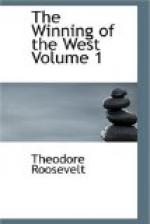However, the backwoodsmen as a class neither built towns nor loved to dwell therein. They were to be seen at their best in the vast, interminable forests that formed their chosen home. They won and kept their lands by force, and ever lived either at war or in dread of war. Hence they settled always in groups of several families each, all banded together for mutual protection. Their red foes were strong and terrible, cunning in council, dreadful in battle, merciless beyond belief in victory. The men of the border did not overcome and dispossess cowards and weaklings; they marched forth to spoil the stout-hearted and to take for a prey the possessions of the men of might. Every acre, every rood of ground which they claimed had to be cleared by the axe and held with the rifle. Not only was the chopping down of the forest the first preliminary to cultivation, but it was also the surest means of subduing the Indians, to whom the unending stretches of choked woodland were an impenetrable cover behind which to move unseen, a shield in making assaults, and a strong tower of defence in repelling counter-attacks. In the conquest of the west the backwoods axe, shapely, well-poised, with long haft and light head, was a servant hardly standing second even to the rifle; the two were the national weapons of the American backwoodsman, and in their use he has never been excelled.
When a group of families moved out into the wilderness they built themselves a station or stockade fort; a square palisade of upright logs, loop-holed, with strong blockhouses as bastions at the corners. One side at least was generally formed by the backs of the cabins themselves, all standing in a row; and there was a great door or gate, that could be strongly barred in case of need. Often no iron whatever was employed in any of the buildings. The square inside contained the provision sheds and frequently a strong central blockhouse as well. These forts, of course, could not stand against cannon, and they were always in danger when attacked with fire; but save for this risk of burning they were very effectual defences against men without artillery, and were rarely taken, whether by whites or Indians, except by surprise. Few other buildings have played so important a part in our history as the rough stockade fort of the backwoods.
The families only lived in the fort when there was war with the Indians, and even then not in the winter. At other times they all separated out to their own farms, universally called clearings, as they were always made by first cutting off the timber. The stumps were left to dot the fields of grain and Indian corn. The corn in especial was the stand-by and invariable resource of the western settler; it was the crop on which he relied to feed his family, and when hunting or on a war trail the parched grains were carried in his leather wallet to serve often as his only food. But he planted orchards and raised melons, potatoes,




